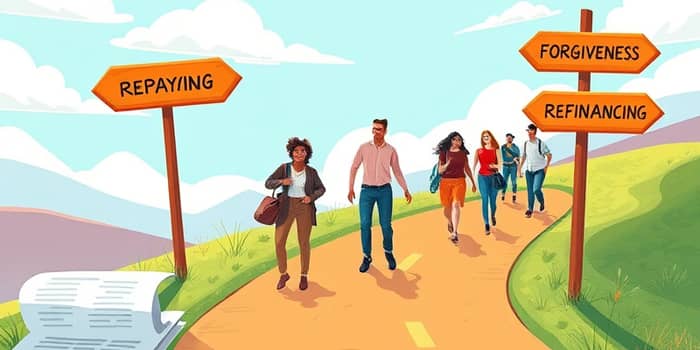
Managing student debt in today’s economic climate can feel overwhelming, yet strategic planning and informed decisions can transform stress into empowerment. Whether you’ve just graduated or are years into repayment, understanding available options in 2025 is key to financial freedom and long-term success.
As of 2025, the United States holds approximately record-high federal student debt at $1.6 trillion. This burden touches over 14.5 million borrowers automatically placed on the standard repayment plan upon leaving school. For loans disbursed after July 1, 2026, the new standard plan spans between 10 and 25 years, depending on the original balance.
Federal and private loans follow significantly different rules and protections. Private lenders typically offer fewer hardship options but can be appealing for refinancing at rates as low as 3–4%. Borrowers face choices with lasting impact on both monthly outlays and overall interest costs.
Reviewing these plans side by side helps determine which approach aligns with your income, career goals, and desired loan payoff timeline.
Forgiveness options can dramatically reduce your remaining balance if you meet program requirements. Understanding each path and its eligibility rules is crucial before committing to a repayment plan.
Private student loans lack federal repayment plans and forgiveness, but they can be refinanced or consolidated through private lenders. For those with strong credit and stable income, refinancing can secure substantially lower interest rates and shorter terms.
Choosing the right repayment strategy depends on your financial situation and long-term goals. Implementing disciplined tactics can reduce interest costs and shorten your payoff period.
If regular payments exceed your budget, consider Income-Driven Repayment plans. These plans adjust your monthly bill based on income and family size, potentially dropping your obligation to $0 in low-income years. However, lower payments likely lead to higher total interest over time.
Short-term solutions like deferment or forbearance can pause payments during financial hardship but risk capitalization of interest, increasing your balance. Always consult your loan servicer before missing payments to preserve credit and prevent unexpected balance growth.
Through the end of 2025, federal loan forgiveness remains tax-free through end of 2025. Legislative proposals may reshape IDR formulas, eligibility criteria, and caps on discretionary income. Borrowers taking out loans after July 1, 2026 will face the new standard plan structure, so plan repayments accordingly.
Staying informed of rule changes and Congressional actions helps you adapt quickly, ensuring you remain on track for forgiveness or efficient repayment without surprises.
Leverage online calculators and official tools to compare repayment scenarios. The Department of Education’s loan simulator projects monthly payments, total interest costs, and payoff dates under different plans. The PSLF Help Tool verifies employer eligibility, tracks qualifying payments, and guides you through the certification process.
Annual recertification for IDR plans is critical: missing deadlines can trigger payment increases and capitalized interest. Mark your calendar to submit documentation promptly each year.
Borrowers with unique circumstances may access tailored options. Married couples should evaluate joint versus separate IDR filings to optimize payments. Certain professions, such as healthcare providers or public defenders, may qualify for additional discharge or forgiveness programs. Borrowers with disabilities should explore the Total and Permanent Disability (TPD) discharge process.
Those with small private loan balances might benefit most from refinancing, while high-balance federal loan holders should prioritize IDR or PSLF enrollment. Personalizing your approach ensures you harness every available advantage on the path to debt freedom.
With the right combination of informed plan selection, disciplined repayment strategies, and utilization of forgiveness opportunities, conquering student debt in 2025 is within reach. Start by assessing your current loan portfolio, exploring repayment calculators, and committing to a strategy that aligns with both your budget and your long-term financial aspirations.
References





